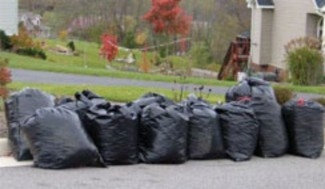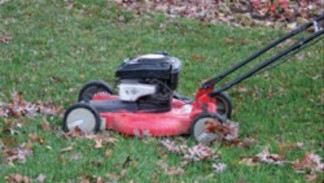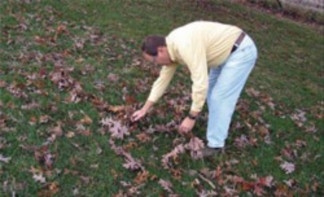"Leave" Them Alone: Lawn Leaf Management
ID
430-521 (SPES-212P)
EXPERT REVIEWED
While we enjoy the beautiful colors associated with fall foliage, we also realize that most of those leaves will soon be on the ground. At this time of year, many turf managers quit managing grass and shift their focus instead to managing leaves. In some situations, leaf removal by way of blowing, raking, or vacuuming is essential because of turf use (e.g. golf course turf where either finding or playing a ball in leaves can be next to impossible). Another reason to mulch or remove leaves is to improve the turf-growing conditions. A thick layer of leaves blocks sunlight, reducing turf growth because of the shading effect. The leaves also trap and hold moisture in the turf canopy, increasing the potential for turf disease. However, treatment and/or disposal of leaves can be time consuming and costly. In some areas, it is actually illegal to place bagged leaves at curbside for pickup due to restrictions on placing lawn waste in landfills.

Are there reasonable alternatives in leaf management? The answer is yes. Of course one method is to collect the leaves and compost them. Many homeowners are committed to this environmentally friendly process, and if you are interested in how to effectively compost yard waste, consult Making Compost from Yard Waste, Virginia Cooperative Extension publication 426-703. Some of us are fortunate enough that our local governments provide leaf pick-up and removal to municipal composting facilities as one of the standard services, many times simply requiring you to get the leaves curbside for removal. But there is also a technique that can be less labor intensive (especially if you have a riding mower), and many of you have used it for years – mulching the leaves directly into the turf.


Numerous university research reports have detailed how leaf mulching affects turf performance. In almost every instance, the results show that chopping up deciduous leaves as part of a regular mowing schedule is an effective means of managing these leaves without harming the turf. A research report from Purdue University entitled “The role of tree leaf mulch and nitrogen fertilizer on turfgrass soil quality” (https://doi.org/10.1007/s003740050524) reported on turfgrass and soil responses of a perennial ryegrass lawn turf to the application of up to 4,000 pounds of maple (Acer sp.) leaves per acre in a single application. Mulching the leaves had no undesirable effects on turf quality or color, growth, thatch accumulation, soil pH, weed populations, or disease pressure. While the leaves did not prove to be a substitute for appropriate N fertilization practices, the general assess- ment was that mulching was overall very positive and economical.
Consider the following issues before using leaf mulching in turf as a method of leaf disposal. While mulching mowers are preferred because they have special deck and/or blade designs to mulch clippings, almost any rotary mower unit can suffice. However, think safety first – use a rotary mower for leaf mulching, but not as a stump grinder or chipper/shredder. Inspect the site and remove sticks and limbs before mulching to reduce the chance that you or someone else will be hurt by flying debris. Wear safety goggles and an air mask over your mouth and nose to protect yourself from debris and dust. Mulching moist leaves minimizes dust concerns, but if leaves are too wet, it increases the strain on your mower’s engine and does not chop the leaves into small pieces that easily decompose in the soil. Next, consider the limitations of the mower itself. There is only so much leaf matter that the mower can handle at one time, so use some common sense regarding how many leaves can be effectively mulched in a single mowing event. Research from Michigan State University (http://migarden.msu.edu/uploads/files/Mulch_fallen_leavesRS.pdf ) indicates that a depth of up to 6 inches of leaves can be successfully mulched at a time, but of course, this will vary depending on the size and performance of your mower. Multiple passes with your mower might be required to thoroughly chop leaves. The Michigan State research also touted an overall reduction in dandelions and crabgrass over time because the leaf mulch covered any voids in the turf where the weeds would germinate in the future! Finally, if you are going to be mulching leaves repeatedly during the fall, both the mulching process and the life of your engine will be improved by keeping your blades sharp and air and fuel filters cleaned.


Unfortunately, the mulching techniques described here do not apply to pine needles because of their size, shape, and composition. Pine needles are highly resistant to microbial breakdown, and even if they are chopped into smaller pieces, they remain physically intact for months. While resistance to decomposition precludes pine needle disposal by mulching, the durability of pine straw is one reason for its popularity as a landscape bedding mulch, so consider using your pine needles around your shrubs and bedding materials. Contact your local Master Gardener chapter or garden club in case they might have members that will be glad to accept your pine straw.
Expanding the use of your rotary or mulching mower into a leaf disposal tool can be highly beneficial in the fall. Mulching leaves directly back to the turf has proven to be a relatively cost effective and time-saving means of leaf disposal, and it is another way of keeping yard waste out of the landfill.
Virginia Cooperative Extension materials are available for public use, reprint, or citation without further permission, provided the use includes credit to the author and to Virginia Cooperative Extension, Virginia Tech, and Virginia State University.
Virginia Cooperative Extension is a partnership of Virginia Tech, Virginia State University, the U.S. Department of Agriculture, and local governments. Its programs and employment are open to all, regardless of age, color, disability, sex (including pregnancy), gender, gender identity, gender expression, genetic information, ethnicity or national origin, political affiliation, race, religion, sexual orientation, or military status, or any other basis protected by law.
Publication Date
July 10, 2020



